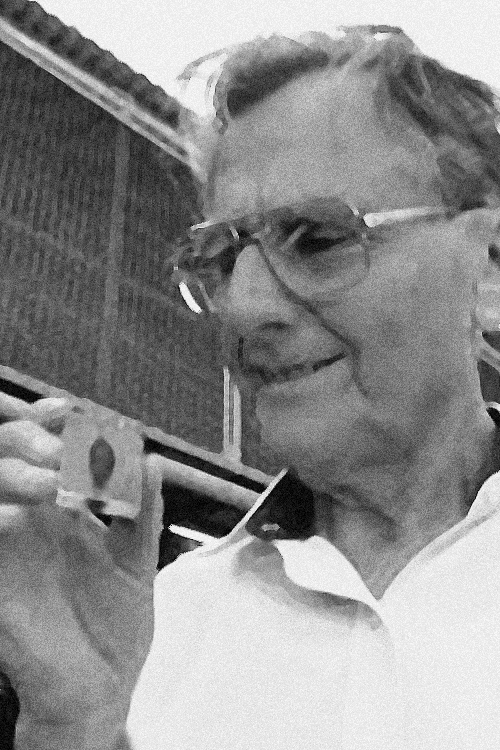
Joe Boray studied Veterinary Science at the University of Budapest, Hungary and gained his DVM in 1950 and worked at the Small Animal Clinic of the Veterinary School. After 3 years of post-graduate studies he received his PhD and became Senior Lecturer of Parasitology at the same University. The epidemiology and control of echinococcosis was the research topic for his PhD but liver fluke disease in ruminants was soon to take over as he examined new and safer parenteral application of carbon tetrachloride, the only real remedy at that time.
Joe, Eva and infant son Peter were part of the wave of migration from Hungary to Australia in the mid-1950s’ and a new life phase began after what was a turbulent and dangerous time in Eastern Europe. In 1956, following widespread student protests, the Hungarian people sought some independence. Many people died and over 200,000 Hungarians fled. These refugees included some of Hungary’s best and brightest and many have made prominent contributions to Australia.
On his arrival in Australia he was employed by the Commonwealth Scientific and Industrial Research Organization (CSIRO) at the McMaster Animal Health Laboratory in Sydney and reached the position of Principal Research Scientist. Liver fluke again was his passion, developing reliable assessment tools to determine the efficacy of drugs as well as defining research on the epidemiology and control of the disease.
A Post-Doctoral Fellowship led Joe back to Europe to the Institute of Parasitology, University of Veterinary Medicine Hannover/Germany under Professor K. Enigk. Joe studied the basic biology of Lymnaeid snails including susceptibility to infection and survival of the metacercariae under different climatic conditions, all basic questions directed at practical control options. In 1968 he joined the Institute of Parasitology of the University of Zurich/Switzerland, in 1971 he was promoted to Associate Professor of Helminthology, teaching parasitology in both the Veterinary and Medical Faculties, until 1972. Together with several colleagues he received a research grant from the Swiss National Science Foundation to work on the epidemiology and control of dicrocoeliosis of sheep and cattle, and continued to work on the chemotherapy and chemoprophylaxis of fasciolosis.
In 1972 Joe joined the Agriculture Division of CIBA-GEIGY and as head of the Ciba Geigy Research Centre, Kemps Creek, Australia. This was a productive time developing many products including amidine compounds for the treatment of resistant cattle tick, triclabendazole for F. hepatica, cyromazine for the prevention of strike from Lucilia cuprina (sheep blowfly) and nitroscanate for the treatment of intestinal parasites of dogs. Many insecticides were also developed to the market for grain protection and household pests. For those from industry, this was a remarkable period in terms of both the number and quality of the products that were developed. To add some formality to his credentials, Joe completed a program on the Management of Research and Development in the Massachusetts Institute of Technology, USA.
As a Principal Research Scientist in the NSW Department of Agriculture, Joe shifted focus to resistance management in internal and external parasites such as Bovicola ovis, (sheep body louse), F. hepatica and Haemonchus contortus (Barbers Pole worm of sheep). New control options for liver fluke was never far away as he led the evaluation of a GST vaccine against F. hepatica and the development of synergistic drug combinations (including patents) for the prevention and treatment of resistant strains. Joe “retired” at age 73 when he received the “Meritorious Service Award” by the Minister of Agriculture in New South Wales. Not having ever retired, Joe continued for many years to produce metacercariae from his well-equipped home laboratory and worked as a consultant to many private and public sector organizations. He was a master of breeding many species of vector snails. At a congress, he was asked what specific conditions snail breeding requires. His short answer was “you should love your snails”.
In over 60 years of research Joe contributed to an enormous wealth of knowledge in veterinary parasitology including the epidemiology and control of trematode diseases, host parasite relationships in trematodes of mammals, humans and the intermediate host snails, the chemotherapy and chemoprophylaxis of trematodes, cestodes, nematodes and external parasites and management of drug resistance in these groups of parasites. His research was always focused on practical outcomes so that farmers and advisors could use the information to manage what are economically important diseases. He developed easy to understand regional control programs for F. hepatica in Australia for sheep and cattle and based on the strong epidemiological science that was researched in his earlier career. These programs were expanded to provide a similar approach in some 42 countries as part of his work with the United Nations Food and Agriculture Organization. Importantly for the disease in human, control programs were developed for the World Health Organization, where he pioneered the use of triclabendazole for humans use. This was an example of “one health” when the term had not been used.
Joe published more than 150 papers, monographs, books and book chapters with much material still sitting in the filing cabinet. Joe was a great mentor to young scientists and students where he imparted his wealth of knowledge and a practical approach to parasitology.
Joe contributed to his profession enormously as a foundation member of the Australian Society for Parasitology (past President and Fellow of the Society), a life member of the Australian Veterinary Association, a foundation member of the World Association for the Advancement of Veterinary Parasitology (WAAVP) and the Australian College of Veterinary Scientists (Fellow, Pharmacology Chapter). He was a registered Specialist Veterinary Surgeon (Pathobiology) with the Board of Veterinary Surgeons of NSW. He was an Honorary Member of the Hungarian Society of Parasitology, the WAAVP and the Latin American Society of Parasitology and past President of the International Society of Medical and Applied Malacology.
Joe was at his best when imparting his passion for liver fluke. His embalmed liver fluke was always in his pocket (encased of course) and ready for immediate display. He was able to communicate this passion to a wide range of audiences from skeptical farmers, hard-nosed pharma scientists, students and bureaucrats. On his softer side, his hobbies (apart from parasitology and liver fluke) were classical music, opera, reading, travelling and gardening. In the background and with all of our admiration, was his wife Joanna who was able to provide support in selfless dedication during Joe’s career and especially in his later years.
Contributors: Peter Rolfe, Johannes Eckert, Steve Love, Bruce Watt, G-Halli Rajasekariah (Raj)


